Youngwoon Lee
UniSkill: Imitating Human Videos via Cross-Embodiment Skill Representations
May 15, 2025Abstract:Mimicry is a fundamental learning mechanism in humans, enabling individuals to learn new tasks by observing and imitating experts. However, applying this ability to robots presents significant challenges due to the inherent differences between human and robot embodiments in both their visual appearance and physical capabilities. While previous methods bridge this gap using cross-embodiment datasets with shared scenes and tasks, collecting such aligned data between humans and robots at scale is not trivial. In this paper, we propose UniSkill, a novel framework that learns embodiment-agnostic skill representations from large-scale cross-embodiment video data without any labels, enabling skills extracted from human video prompts to effectively transfer to robot policies trained only on robot data. Our experiments in both simulation and real-world environments show that our cross-embodiment skills successfully guide robots in selecting appropriate actions, even with unseen video prompts. The project website can be found at: https://kimhanjung.github.io/UniSkill.
TLDR: Unsupervised Goal-Conditioned RL via Temporal Distance-Aware Representations
Jul 11, 2024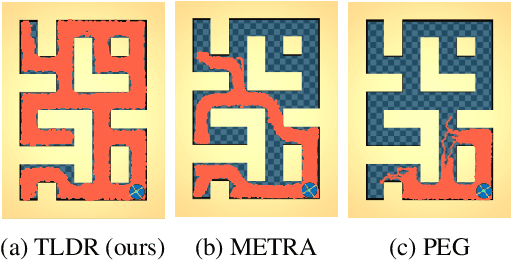

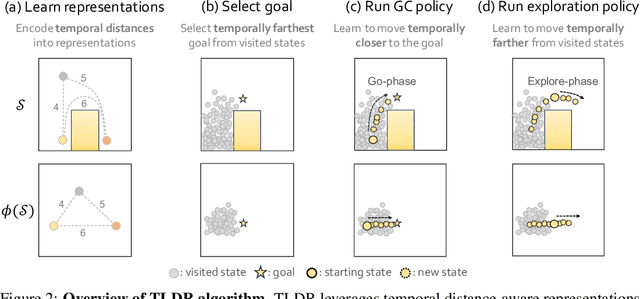
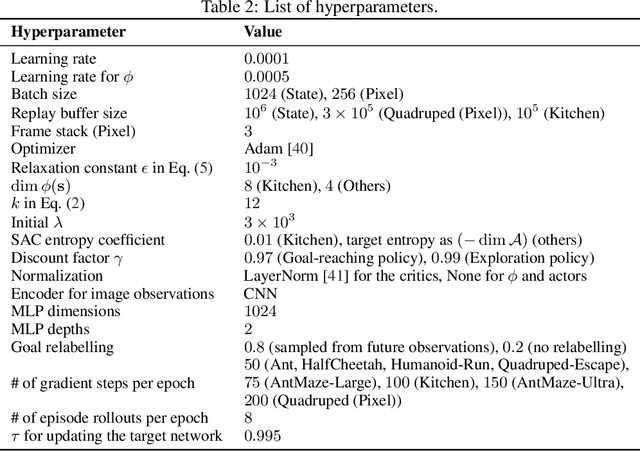
Abstract:Unsupervised goal-conditioned reinforcement learning (GCRL) is a promising paradigm for developing diverse robotic skills without external supervision. However, existing unsupervised GCRL methods often struggle to cover a wide range of states in complex environments due to their limited exploration and sparse or noisy rewards for GCRL. To overcome these challenges, we propose a novel unsupervised GCRL method that leverages TemporaL Distance-aware Representations (TLDR). TLDR selects faraway goals to initiate exploration and computes intrinsic exploration rewards and goal-reaching rewards, based on temporal distance. Specifically, our exploration policy seeks states with large temporal distances (i.e. covering a large state space), while the goal-conditioned policy learns to minimize the temporal distance to the goal (i.e. reaching the goal). Our experimental results in six simulated robotic locomotion environments demonstrate that our method significantly outperforms previous unsupervised GCRL methods in achieving a wide variety of states.
Tackling Long-Horizon Tasks with Model-based Offline Reinforcement Learning
Jun 30, 2024Abstract:Model-based offline reinforcement learning (RL) is a compelling approach that addresses the challenge of learning from limited, static data by generating imaginary trajectories using learned models. However, it falls short in solving long-horizon tasks due to high bias in value estimation from model rollouts. In this paper, we introduce a novel model-based offline RL method, Lower Expectile Q-learning (LEQ), which enhances long-horizon task performance by mitigating the high bias in model-based value estimation via expectile regression of $\lambda$-returns. Our empirical results show that LEQ significantly outperforms previous model-based offline RL methods on long-horizon tasks, such as the D4RL AntMaze tasks, matching or surpassing the performance of model-free approaches. Our experiments demonstrate that expectile regression, $\lambda$-returns, and critic training on offline data are all crucial for addressing long-horizon tasks. Additionally, LEQ achieves performance comparable to the state-of-the-art model-based and model-free offline RL methods on the NeoRL benchmark and the D4RL MuJoCo Gym tasks.
DROID: A Large-Scale In-The-Wild Robot Manipulation Dataset
Mar 19, 2024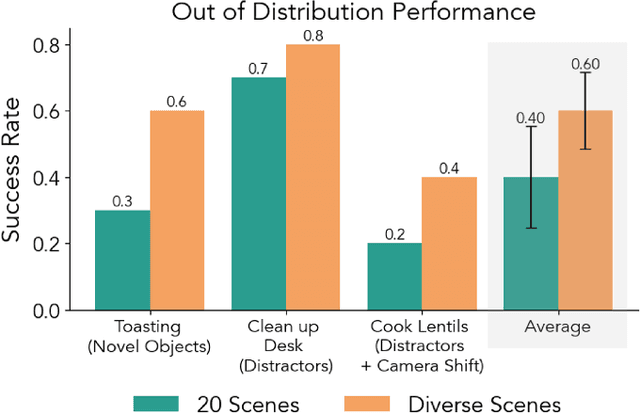
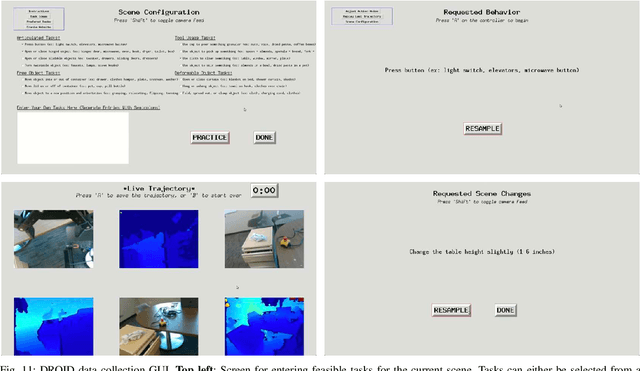
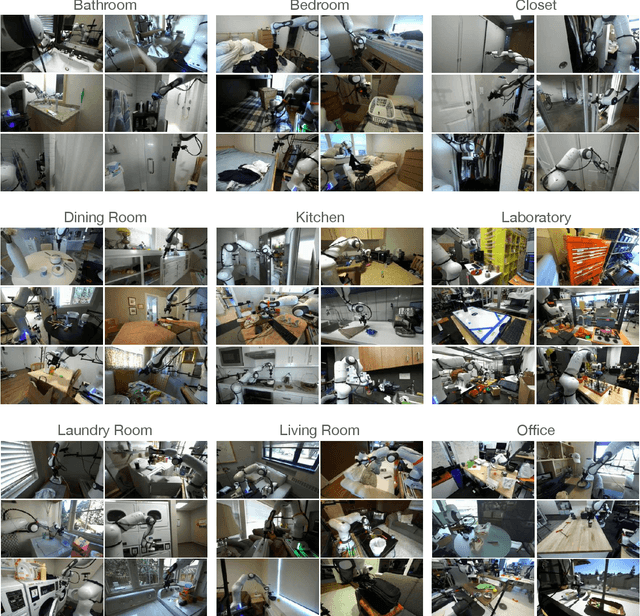
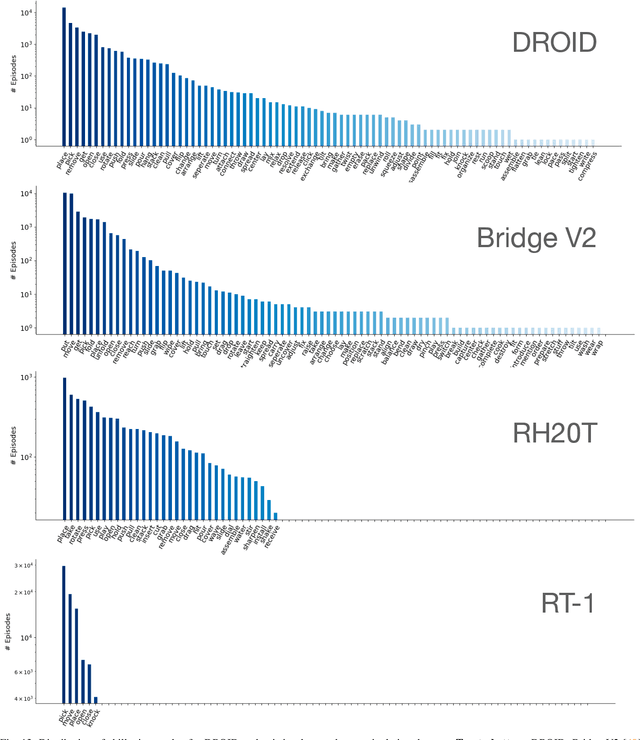
Abstract:The creation of large, diverse, high-quality robot manipulation datasets is an important stepping stone on the path toward more capable and robust robotic manipulation policies. However, creating such datasets is challenging: collecting robot manipulation data in diverse environments poses logistical and safety challenges and requires substantial investments in hardware and human labour. As a result, even the most general robot manipulation policies today are mostly trained on data collected in a small number of environments with limited scene and task diversity. In this work, we introduce DROID (Distributed Robot Interaction Dataset), a diverse robot manipulation dataset with 76k demonstration trajectories or 350 hours of interaction data, collected across 564 scenes and 84 tasks by 50 data collectors in North America, Asia, and Europe over the course of 12 months. We demonstrate that training with DROID leads to policies with higher performance and improved generalization ability. We open source the full dataset, policy learning code, and a detailed guide for reproducing our robot hardware setup.
HumanoidBench: Simulated Humanoid Benchmark for Whole-Body Locomotion and Manipulation
Mar 15, 2024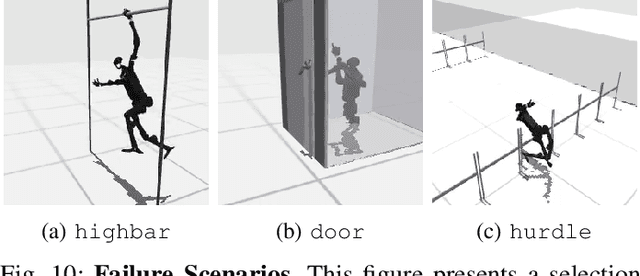
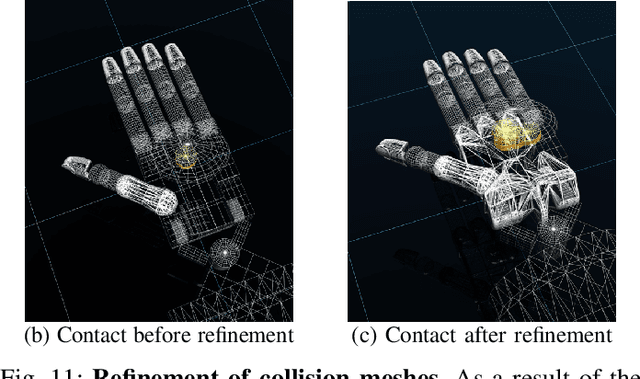
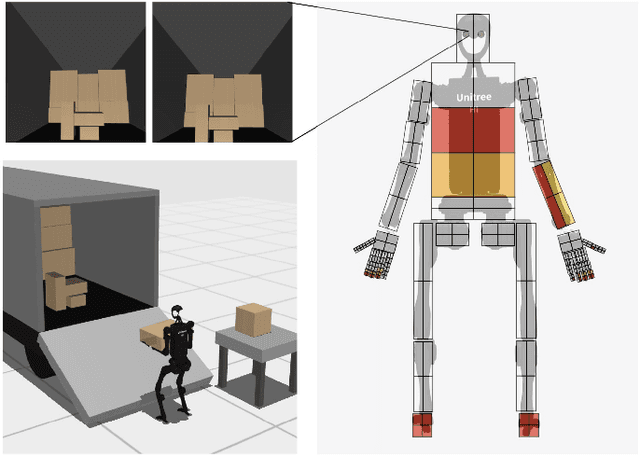
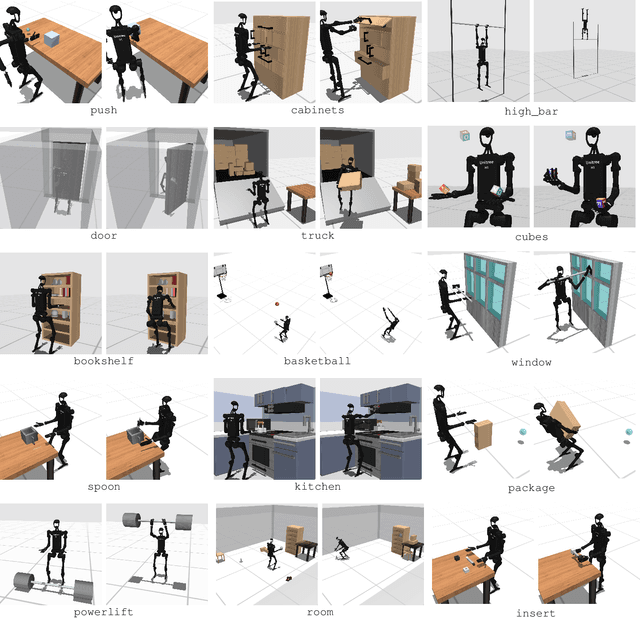
Abstract:Humanoid robots hold great promise in assisting humans in diverse environments and tasks, due to their flexibility and adaptability leveraging human-like morphology. However, research in humanoid robots is often bottlenecked by the costly and fragile hardware setups. To accelerate algorithmic research in humanoid robots, we present a high-dimensional, simulated robot learning benchmark, HumanoidBench, featuring a humanoid robot equipped with dexterous hands and a variety of challenging whole-body manipulation and locomotion tasks. Our findings reveal that state-of-the-art reinforcement learning algorithms struggle with most tasks, whereas a hierarchical learning baseline achieves superior performance when supported by robust low-level policies, such as walking or reaching. With HumanoidBench, we provide the robotics community with a platform to identify the challenges arising when solving diverse tasks with humanoid robots, facilitating prompt verification of algorithms and ideas. The open-source code is available at https://sferrazza.cc/humanoidbench_site.
The Power of the Senses: Generalizable Manipulation from Vision and Touch through Masked Multimodal Learning
Nov 02, 2023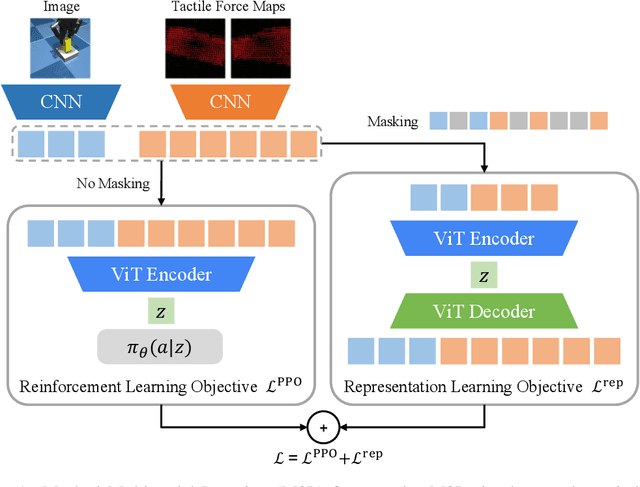

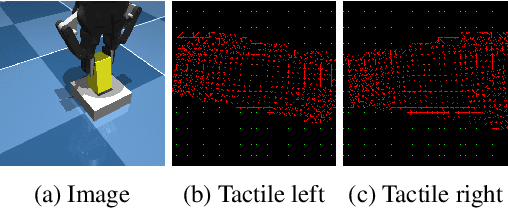

Abstract:Humans rely on the synergy of their senses for most essential tasks. For tasks requiring object manipulation, we seamlessly and effectively exploit the complementarity of our senses of vision and touch. This paper draws inspiration from such capabilities and aims to find a systematic approach to fuse visual and tactile information in a reinforcement learning setting. We propose Masked Multimodal Learning (M3L), which jointly learns a policy and visual-tactile representations based on masked autoencoding. The representations jointly learned from vision and touch improve sample efficiency, and unlock generalization capabilities beyond those achievable through each of the senses separately. Remarkably, representations learned in a multimodal setting also benefit vision-only policies at test time. We evaluate M3L on three simulated environments with both visual and tactile observations: robotic insertion, door opening, and dexterous in-hand manipulation, demonstrating the benefits of learning a multimodal policy. Code and videos of the experiments are available at https://sferrazza.cc/m3l_site.
DreamSmooth: Improving Model-based Reinforcement Learning via Reward Smoothing
Nov 02, 2023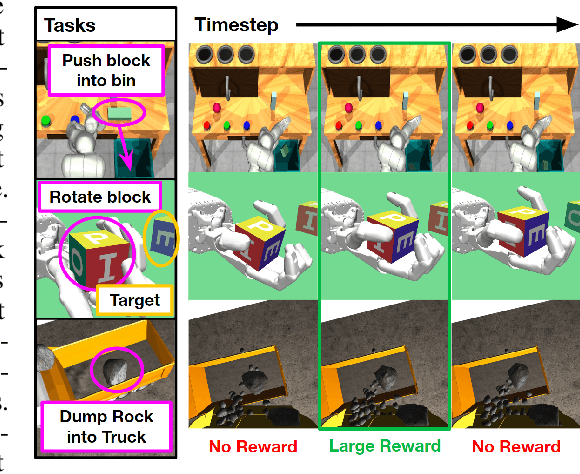

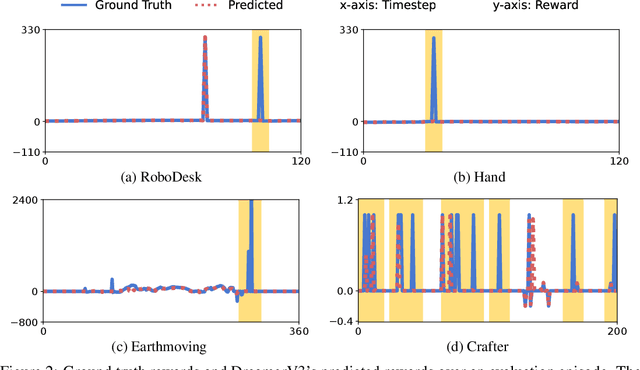

Abstract:Model-based reinforcement learning (MBRL) has gained much attention for its ability to learn complex behaviors in a sample-efficient way: planning actions by generating imaginary trajectories with predicted rewards. Despite its success, we found that surprisingly, reward prediction is often a bottleneck of MBRL, especially for sparse rewards that are challenging (or even ambiguous) to predict. Motivated by the intuition that humans can learn from rough reward estimates, we propose a simple yet effective reward smoothing approach, DreamSmooth, which learns to predict a temporally-smoothed reward, instead of the exact reward at the given timestep. We empirically show that DreamSmooth achieves state-of-the-art performance on long-horizon sparse-reward tasks both in sample efficiency and final performance without losing performance on common benchmarks, such as Deepmind Control Suite and Atari benchmarks.
Open X-Embodiment: Robotic Learning Datasets and RT-X Models
Oct 17, 2023



Abstract:Large, high-capacity models trained on diverse datasets have shown remarkable successes on efficiently tackling downstream applications. In domains from NLP to Computer Vision, this has led to a consolidation of pretrained models, with general pretrained backbones serving as a starting point for many applications. Can such a consolidation happen in robotics? Conventionally, robotic learning methods train a separate model for every application, every robot, and even every environment. Can we instead train generalist X-robot policy that can be adapted efficiently to new robots, tasks, and environments? In this paper, we provide datasets in standardized data formats and models to make it possible to explore this possibility in the context of robotic manipulation, alongside experimental results that provide an example of effective X-robot policies. We assemble a dataset from 22 different robots collected through a collaboration between 21 institutions, demonstrating 527 skills (160266 tasks). We show that a high-capacity model trained on this data, which we call RT-X, exhibits positive transfer and improves the capabilities of multiple robots by leveraging experience from other platforms. More details can be found on the project website $\href{https://robotics-transformer-x.github.io}{\text{robotics-transformer-x.github.io}}$.
Language-Conditioned Path Planning
Aug 31, 2023Abstract:Contact is at the core of robotic manipulation. At times, it is desired (e.g. manipulation and grasping), and at times, it is harmful (e.g. when avoiding obstacles). However, traditional path planning algorithms focus solely on collision-free paths, limiting their applicability in contact-rich tasks. To address this limitation, we propose the domain of Language-Conditioned Path Planning, where contact-awareness is incorporated into the path planning problem. As a first step in this domain, we propose Language-Conditioned Collision Functions (LACO) a novel approach that learns a collision function using only a single-view image, language prompt, and robot configuration. LACO predicts collisions between the robot and the environment, enabling flexible, conditional path planning without the need for manual object annotations, point cloud data, or ground-truth object meshes. In both simulation and the real world, we demonstrate that LACO can facilitate complex, nuanced path plans that allow for interaction with objects that are safe to collide, rather than prohibiting any collision.
Video Prediction Models as Rewards for Reinforcement Learning
May 23, 2023Abstract:Specifying reward signals that allow agents to learn complex behaviors is a long-standing challenge in reinforcement learning. A promising approach is to extract preferences for behaviors from unlabeled videos, which are widely available on the internet. We present Video Prediction Rewards (VIPER), an algorithm that leverages pretrained video prediction models as action-free reward signals for reinforcement learning. Specifically, we first train an autoregressive transformer on expert videos and then use the video prediction likelihoods as reward signals for a reinforcement learning agent. VIPER enables expert-level control without programmatic task rewards across a wide range of DMC, Atari, and RLBench tasks. Moreover, generalization of the video prediction model allows us to derive rewards for an out-of-distribution environment where no expert data is available, enabling cross-embodiment generalization for tabletop manipulation. We see our work as starting point for scalable reward specification from unlabeled videos that will benefit from the rapid advances in generative modeling. Source code and datasets are available on the project website: https://escontrela.me
 Add to Chrome
Add to Chrome Add to Firefox
Add to Firefox Add to Edge
Add to Edge